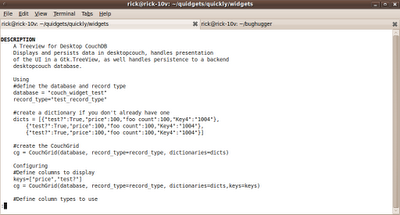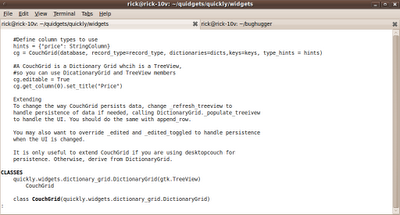One thing is, Quidgets need a better name. "Quidgets" was a sort of as a joke. "Quidgets" does have teh advantage of being silly, and maybe keeps folks from taking it too seriously. It's good the name that expresses that. But maybe it's time to boost the configence of the project. So didrocks repackage quidgets as "quickly-widgets", now the namespace is quickly.widgets, quickly.prompts, etc... We'll see how it goes.
Any hoo...
Use
The start of quickly.widgets was focused on one-liners, making it take no more than a line or two to use a quickly.widget. It's good to try to make it easy and fun to write programs. So for instance, with DictionaryGrid, all you need is a dictionary and one line to create the DictionaryGrid, and you are displaying tabular information to users:
#create a dictionary if you don't already have one
dicts = [{"test?":True,"price":100,"foo count":100,"Key4":"1004"},
{"test?":True,"price":100,"foo count":100,"Key4":"1004"},
{"test?":True,"price":100,"foo count":100,"Key4":"1004"}]
#create the DictionaryGrid
dg = DictionaryGrid(dictionaries=dicts)
Configure
However, sometimes you have to tweak a quickly.widget for your needs. It's best when most of the essential functionality is provided, but perhaps you have to write a few more lines of code to configure the quickly.widget. This is the "configuring" level of consuming, You can write a few lines of code to set properties and call functions on a quickly.widget. It's a bit more work, but I the code should be easy to write as well. Somtimes the code for configuring a quickly.widget requires knowing or learning about a few parts of the underlying PyGtk library. Sometimes you have to learn about another quickly.widget. For instance, with DictionaryGrid you can configure the types of columns to use:
#Define column types to use
hints = {"price": StringColumn}
dg = CouchGrid(dictionaries=dicts,keys=keys, type_hints = hints)
dg.get_column(0).set_title("Price")
blank_filter = BlankFilterCombo()
blank_filter.append("=",custom_equals_function )
blank_filter.append("<>",custom_no_equals_function )
filter_hints = {"status":blank_filter}
filt = GridFilter(grid, filter_hints)
For some applications there will be way way way too much code just configure an object, so you might end up extending a quickly.widget. For example, I was trying to add offline bug editing for Bughugger. The code was hard to modify starting after only about an hour into writing it because just configuing a DictionryGrid to save it's data in Desktopcouch required too much code strewn about the bughugger code file. So instead, I extended DictionaryGrid to be the new CouchGrid. Doing this required lots of knowledge of the DictionaryGrid widget, DesktopCouch, and PyGtk. However, my requirement was supported and the code is reusable.
I'm hoping to see in time an application library that is easy to use for task at hand, using, configuring, or extending.
Sadly, I have been totally lame about writing documentation for quickly widgets. So I have started doing proper pydoc documentation, adding a use, configure, and extend section to each module. For example, for couch_grid the module documentation now works in pydoc and includes an overview in addition to the reference for each function:


I've gotten dictionary_grid and grid_filter modules done so far, and in trunk.
This is great news, I'll think about making a Wiki page on the french Ubuntu wiki just like I did with Quickly.
ReplyDeleteThanks for helping me to understand basic concepts.Your post will be helpful for everyone
ReplyDeleteMulesoft Online Training
Mulesoft Training in Hyderabad
very interesting, good job and thanks for sharing such a good blog. Seo Services Delhi
ReplyDeleteHi.Very Good Article.Thanks For Sharing. Keep Up Tha Good Work
ReplyDeleteSEO Training in Pune
SEO Training in Mumbai
SEO Training in Delhi
SEO Training in Bangalore
SEO Training in Hyderabad
I read this post your post so nice and very informative post thanks for sharing this post. Youtube Mp3 Converter
ReplyDeleteNice post.Bibliography maker
ReplyDeleteReceive the No.1 Selenium Training in Chennai from Infycle Technologies, for techies, freshers, and students at the best offers. In addition to the Selenium, other in-demand courses such as Java, Power BI, Digital Marketing, Python, Big Data, Web Development & Design, Oracle, Cyber Security also will be trained with hands-on practical classes. Get a free demo and more info by calling 7504633633.
ReplyDeleteI Really Excited to read your Article
ReplyDeletedevops training in hyderabad
more information about IT world you can find on Mobilunity for details
ReplyDeleteFortunately, 2019 accompanied the arrival of independent VR frameworks. The year was supposed to be over and above anyone's expectations for augmented reality development as customers are liberated from wires, laptops, and telephones. What's more, it figured out how to satisfy hopes. As independent VR frameworks offer expanded convenience, solace, and movability, it appears to be computer generated reality is going towards the standard achievement its been pursuing. Interest and development are supposed to keep on rising. It is anticipated that computer generated experience will be a $38 billion industry by 2026.
ReplyDeleteWith respect to the year 2020, the VR/AR industry has reached $18.8 billion internationally. The nations that put more in VR programming advancement are the USA and China. Augmented reality advancement cost and ubiquity accompany its possibilities in medical services, military, and science>> Mobilunity
Data engineers are named, and most importantly, highly specialized specialists, and at an interview you can ask a huge number of questions that you need to be prepared for - by clicking on the website link you will get access to a collection of basic interview questions, so you can prepare and increase your chances for success.
ReplyDeleteThis comment has been removed by the author.
ReplyDeleteI have read this post. collection of post is a nice one..!!
ReplyDeleteTableau Online Training Coaching
Best Selenium Online Training
SAP ABAP Certification Training In Singapore
Artificial Intelligence Training from UK
DevOps with AWS Training
C++ programming Language Training from Hyderabad
Azure Cloud Training from Pune
Angular Training Course In Hyderabad
Best Full Stack Web Development Training from Hyderabad